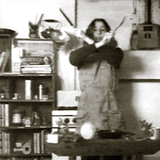-

Beautiful Smudge
A cricket field, like the sky, is ever-changing. Things move around, you move around; time passes.
-

Peripheral Vision
For an institution that in its scale and effectiveness helped to inaugurate modernity, and is still the nexus of contemporary food production, the abattoir is a lacuna in our literature. Railways, the cinema, the factory, the car: all of these have had their songs of praise. The abattoir inspires no hymns, and its poets remain, like their subject, on the edge of things.
-

Career Opportunities
It is fitting that Rude Boy, one of the earliest punk films, should exist in a fraught space somewhere between documentary and fiction. The punk scene it charts and the band at the heart of it were products—with everything that word implies—of the tension between real life and pop spectacle, street fighting and street theatre, revolution and its recuperation into just another set of empty signifiers.
-

Girls Don't Cry
But there are stops on the network where no one wants to disembark: the stations where if you hang around for long you get called crazy. There goes Janis Joplin, Whitney Houston, Amy Winehouse, Britney Spears, Courtney Love, Sinéad O’Connor, Azealia Banks, and on and on, rushing past the window. The stations of the sad women, who are known as madwomen.
-

To the Birds
Suede is porous: a queer material.
-

24 Hour Theory People
‘Contemporary culture has eliminated both the concept of the public and the figure of the intellectual’, Mark wrote in his founding statement for Zer0 Books, an imprint that he established with Tariq Goddard in 2009, in order to promulgate the best of the blogosphere in book form. But Mark was an intellectual, and one fiercely dedicated to the possibilities of the public: the popular, the common, the collective.
-

Howl Sky
See me. See this. Wojnarowicz calls you to witness, which is why his work feels so intimate even when he’s really addressing everyone at once. These days I see the edge of mortality.
-

The Letters of Sylvia Plath
The belief among many of Plath’s devotees seems to be that if we can get clear of other people’s fingerprints on her texts, allowing Plath to “fully narrate her own autobiography,” as the editors here describe it, we will at last solve the riddle of her. The extremities of her poetry will balance against the circumstances of her life; the latter will equal the former.
-

A Thousand Feet Per Second
The standard gloss on OK Computer, both at the time of its release and in the 20 years since, has been to call it an album about technology. But it seemed clear even in 1997 that it was also—or more so—an album about infrastructure, both the physical infrastructure of “motorways and tramlines,” as Yorke hymned it on “Let Down,” and the more elusive, “soft” infrastructure of global logistics, surveillance, finance, and banking.
-

Towards Joy
I don’t hate literature, honestly. (I wouldn’t be a writer if that were so.) But I do resent efforts, no matter how well intentioned, to make pop music fit the criteria of an entirely different art form.
-

No Place Like Home
There is a persistent idea that social housing tenants in Millers Point are somehow gaming the system, living it up in grand terraces with harbour views while the rest of low-income Sydney sweats it out in the suburbs. In characterising the sell-off as a policy that will bring ‘fairness’ to the social housing system, the state government has only furthered this misconception.
-

This Isn't Working
Stereotypes of single motherhood remain strong in this country, particularly in the media, where single mothers are often depicted as lazy and manipulative—out to get what they can from welfare.